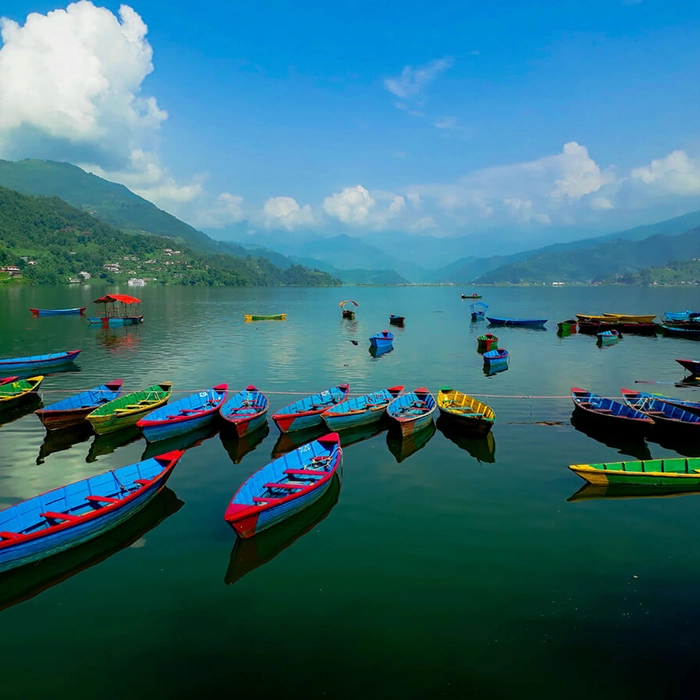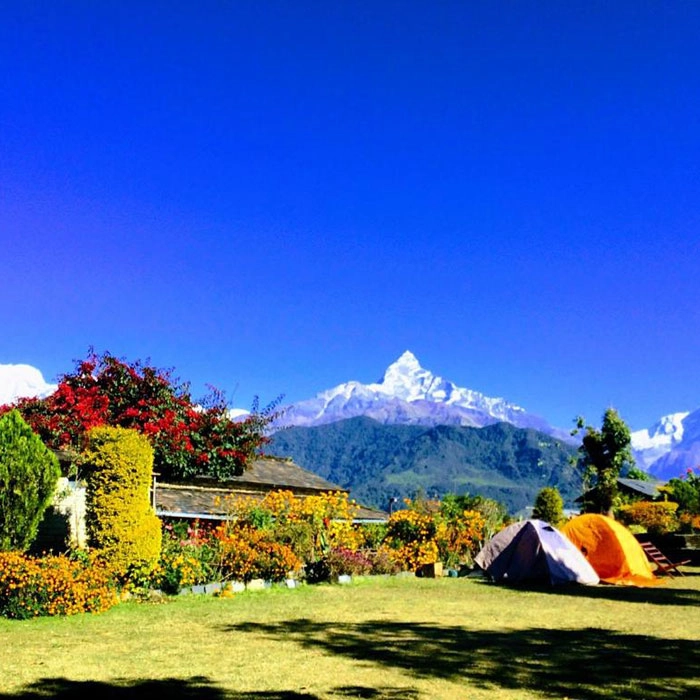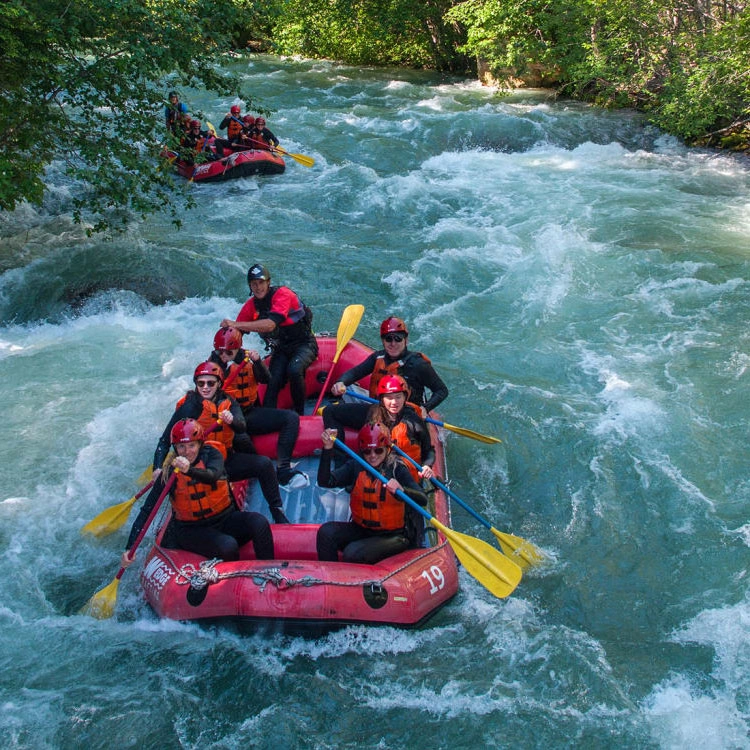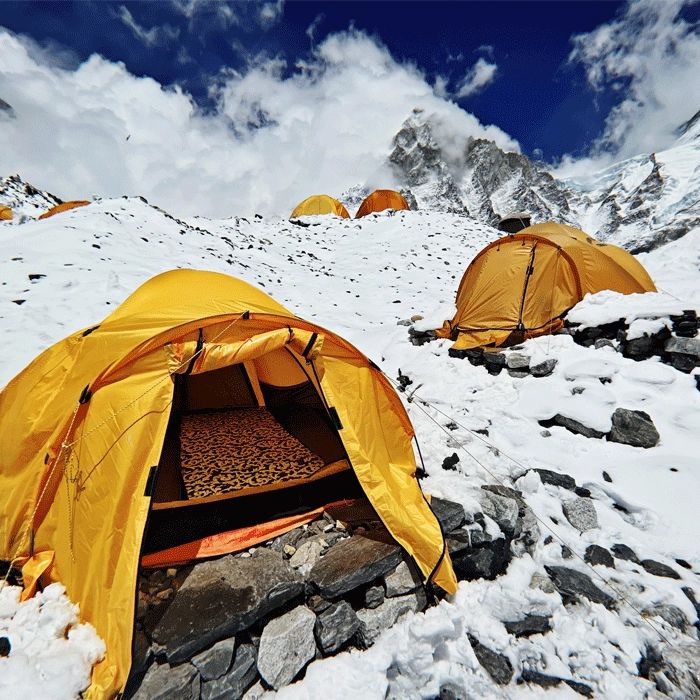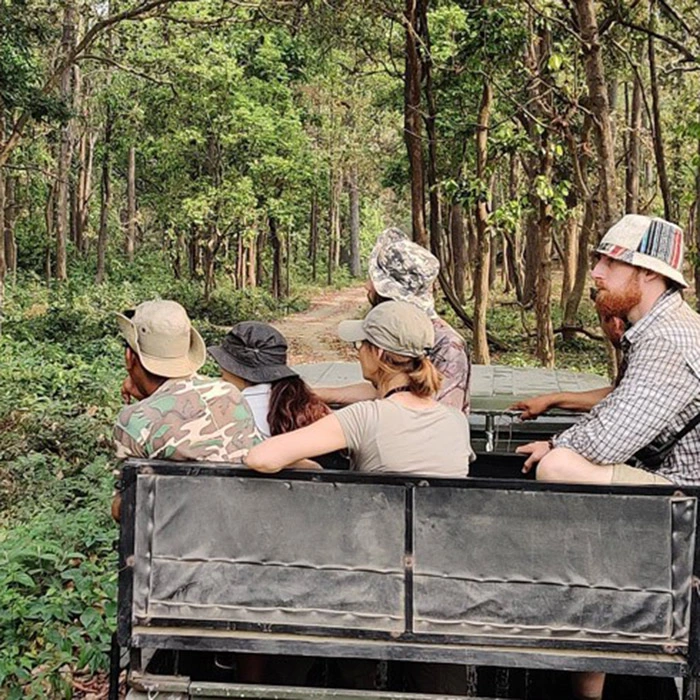EVEREST BASE CAMP TREK WITH HELICOPTER RETURN
US$4,600.00
/pp
-
12 Days
-
Everest
-
Spring/Autumn
-
Trekking
-
5,550 Meters
-
Hard
-
Plane / Heli
-
01-16 People
-
JH#223X
 Overviews
Overviews
Embark on the iconic Everest Base Camp Trek with Helicopter Return, a 12-day Himalayan adventure with Jagadamba Holidays that perfectly blends traditional trekking with a scenic and time-saving helicopter exit. This Everest Base Camp Trek with Helicopter return offers the best of the Everest region, from rugged mountain trails and Sherpa culture to panoramic views of the world’s highest peaks—all without the strenuous multi-day trek back.
Your Everest Base Camp Trek with Helicopter return journey begins with a fixed-wing domestic flight from Kathmandu or Ramechhap airport to Lukla (Tenzing-Hillary Airport), depending on the season. Trek through the beautiful Sagarmatha National Park, visit vibrant Sherpa villages like Namche Bazaar, and explore spiritual sites such as Tengboche Monastery. Experience awe-inspiring landscapes including the Khumbu Glacier and take in the unforgettable sunrise from Kala Patthar (5,550 m) overlooking Everest in this Everest Base Camp Trek with Helicopter return.
After the sunrise hike to Kala Patthar, return to Gorakshep for breakfast. Your return journey then begins with a private charter helicopter flight to Lukla, departing either from Gorakshep or Lobuche, depending on weather conditions and group size. Once in Lukla, enjoy some free time before boarding a shared helicopter flight to Kathmandu, completing your Everest Base Camp Trek with Helicopter return with convenience and comfort. This helicopter return saves you the exhausting multi-day hike back while offering breathtaking aerial views of the Himalayas.
Throughout the Everest Base Camp Trek with Helicopter Return trek, you’ll benefit from expert guides, well-planned acclimatization days, comfortable teahouse stays, and comprehensive support—ensuring a safe, unforgettable, and hassle-free Everest trekking experience. Everest Base Camp Trek with Helicopter Return DifficultyThe Everest Base Camp Trek with Helicopter Return is considered moderate to challenging, suitable for trekkers with a good level of fitness and some prior hiking experience. The trekking portion follows the classic Everest route, involving 6 to 8 hours of walking per day through rugged mountain terrain, suspension bridges, and high-altitude villages, reaching a maximum elevation of 5,364 meters (17,598 ft) at Everest Base Camp. The main challenges are altitude, cold temperatures, and the physical effort required for sustained trekking. However, the helicopter return reduces the strain of a long descent and eliminates the need for a multi-day return hike, making it an appealing option for those seeking a rewarding Himalayan adventure with less physical wear and faster recovery. Everest Base Camp Trek with Helicopter Return CostThe Everest Base Camp Trek with Helicopter Return cost typically includes essential trekking services such as a licensed guide, porter support, Sagarmatha National Park and local permits, teahouse accommodation, meals during the trek, and round-trip domestic flights (Kathmandu–Lukla). It also covers the helicopter flight from Everest Base Camp or Pheriche back to Kathmandu, offering a swift and scenic descent. Solo trekkers receive personalized attention, while groups enjoy tiered pricing, with the per-person rate decreasing as group size increases. We also offer special seasonal promotions during off-peak trekking seasons. Though our website lists standard international rates, you can contact us directly for custom group quotes, where we promise the best possible price without compromising on safety, comfort, or service quality, making your Everest adventure both efficient and unforgettable.
 Itinerary (Plan)
Itinerary (Plan)
Arrive in Kathmandu, Nepal's vibrant capital, where you'll be warmly welcomed with marigold garlands. After transferring to your hotel, take time to relax and acclimate to the bustling city. Discover vibrant local markets, indulge in traditional Nepali dishes, and delve into Kathmandu's rich cultural tapestry. This initial day is perfect for easing into your journey, setting the stage for the exciting adventures ahead in Eastern Nepal. A representative from Jagadamba Holidays will ensure a smooth and pleasant arrival.
Optional Evening Activity:
If you wish, you can spend your evening experiencing the Pashupatinath Aarti, a captivating religious ceremony held at the Pashupatinath Temple. The Aarti usually begins around 6:00 PM and lasts for approximately an hour. This ceremony is a mesmerizing display of traditional music and rituals, providing a profound insight into Hindu spiritual practices. Please check the exact time for the Aarti on the day of your visit, as it may vary. This option is not included in the standard itinerary but offers a unique opportunity to immerse yourself in local culture.
Normally, we book a flight from Kathmandu to Lukla (2,846 m / 9,350 ft.); however, if we are unable to secure a direct flight for some reason, we will need to take an alternative flight option via Ramechhap. If our flight to Lukla is scheduled from Manthali and we have extra time, we will explore the Kathmandu Valley before driving to Manthali for an overnight stay. However, if time is limited, we will depart from Kathmandu at 2 AM to catch the flight on Day 2. This will take approximately four hours to cover the distance of 132 kilometers to Manthali.
This early departure ensures that we arrive in time for the first flight from Ramechhap to Lukla, which departs at 6:30 AM. We will leave Kathmandu according to our scheduled departure time to guarantee a smooth journey to the airport.
Upon arrival at Lukla, your guide will introduce you to your porter. After a brief tea break, we will commence our trek to Phakding (2,620 m / 8,595 ft.). Phakding, a picturesque village and the largest settlement in the area, serves as an ideal first stop for many trekkers spending their initial night in the mountains. Once you arrive in Phakding, you'll enjoy a one-hour break to relax and take in the stunning surroundings. It is recommended to meet with your guide in the lobby afterward to discuss the evening's activities and the schedule for the following day.
Following your refreshment break at Lukla, embark on your trek to Phakding, traversing the scenic route through Nurning Ghat (2,590 m). The trek covers about 8.5 kilometers and takes approximately 3 to 4 hours. During this journey, you will ascend 190 meters and descend 380 meters.
After your breakfast at the lodge, embark on your trek to Namche Bazaar (3,440 m / 11,286 ft.), traversing the scenic route through Monjo (2,835 m). The trek covers about 9.5 kilometers and takes approximately 5 to 6 hours. During this journey, you will ascend 860 meters and descend 190 meters.
We embark on a picturesque trek in the Khumbu region along the Dudh Koshi River. Here, we'll cross stunning suspension bridges adorned with colorful prayer flags. As we navigate the trail, we pass through charming Sherpa villages and lush rhododendron forests, steadily ascending while soaking in breathtaking views of majestic snow-capped peaks.
This journey offers both beauty and challenge, making every step worthwhile. Upon reaching Namche Bazaar (3,440 m / 11,286 ft.), the largest Sherpa village and a vital trading hub, we’ll have ample opportunity to acclimatize to the altitude.
Namche Bazaar's vibrant market is bustling with shops, cafes, and bakeries, creating a lively atmosphere against the dramatic Himalayan backdrop. After checking into our lodge, you can relax, hydrate, and enjoy a warm meal. In the evening, we’ll gather with our group to share stories and reflect on the day’s adventures, setting the stage for an exciting acclimatization day ahead.
This trek from Phakding to Namche Bazaar not only showcases stunning vistas but also immerses you in the rich Sherpa culture, making it a memorable part of your Everest Base Camp journey.
Make the most of your rest day in Namche Bazaar by acclimatizing to the altitude and immersing yourself in the stunning beauty of the Khumbu region. After a hearty breakfast, you can either explore the vibrant town of Namche or embark on an optional scenic trek to Khunde, passing through Khumjung village, with a stop at the renowned Everest View Hotel (3,880 m / 12,730 ft.).
This picturesque hike to Khunde offers breathtaking views of the world's tallest peaks, including Mount Everest, Lhotse, and Ama Dablam. The well-marked trail is relatively steep, rewarding trekkers with panoramic vistas and ample opportunities for memorable photographs. At the Everest View Hotel, take a moment to pause for refreshments while soaking in the magnificent surroundings before continuing your journey to Khunde, a charming Sherpa village rich in culture and history.
Once in Khunde, explore local attractions such as the Sherpa museum and historic monasteries, which showcase the unique heritage of the Sherpa people. After your trek, return to Namche Bazaar for a leisurely lunch and some free time to visit local shops, purchase trekking gear, or unwind at a cozy café with stunning mountain views.
In the evening, gather with your group to share stories from your day and enjoy a warm meal together. This day of exploration and acclimatization not only enriches your experience in the Himalayas but also prepares you for the exciting adventures that lie ahead.
The round-trip trek from Namche Bazaar to Khunde via the Everest View Hotel and Khumjung covers approximately 8.15 kilometers and typically takes 5 to 6 hours. During the journey, you will ascend 550 meters and descend 550 meters.
Begin your trek from Namche Bazaar, the vibrant Sherpa hub, and journey through stunning rhododendron forests and picturesque landscapes. The trail ascends past the famous Everest View Hotel, offering breathtaking panoramic views of Everest, Lhotse, and Ama Dablam. Continue to the tranquil village of Tengboche, home to the iconic Tengboche Monastery—the spiritual heart of the Khumbu region.
At 3,860 meters (12,664 feet), Tengboche provides an ideal spot to rest and acclimatize. The trek covers approximately 10 km, taking 4-5 hours with an ascent of 780 meters and a descent of 350 meters. Along the way, cross suspension bridges over roaring rivers and immerse yourself in Sherpa culture and Buddhist traditions. Overnight stays are in local teahouses, offering a warm and authentic Himalayan experience.
This trek offers a perfect blend of awe-inspiring mountain vistas and meaningful cultural experiences—making it a highlight for adventurers and cultural enthusiasts alike.
After breakfast, the trek begins from Tengboche, renowned for its historic monastery and breathtaking panoramic views of Mount Everest, Lhotse, and Ama Dablam. This popular route winds through traditional Sherpa villages such as Deboche and Shomare, where trekkers cross suspension bridges spanning mountain rivers while soaking in spectacular Himalayan scenery.
The trail gradually ascends beyond Deboche, becoming more rugged as you trek through Shomare towards Dingboche. Situated at 4,410 meters (14,239 feet), Dingboche serves as a crucial acclimatization stop on the Everest Base Camp trekking route, offering awe-inspiring panoramic vistas of the surrounding Himalayan peaks.
The trekking journey covers approximately 11 kilometres and takes around 6 to 7 hours to complete. Along the way, you will ascend 630 meters and descend 170 meters, experiencing a perfect balance of challenge and reward. With every step, stunning Himalayan panoramas unfold, making this trek an unforgettable adventure. Evenings are spent in cosy local teahouses, where warm Sherpa hospitality and rich cultural traditions await to welcome you.
This trek from Tengboche to Dingboche is an essential segment of the Everest Base Camp journey, seamlessly combining cultural immersion with magnificent mountain landscapes.
Today is dedicated to acclimatization, allowing your body to adjust to the altitude and preparing you for the trekking challenges ahead. After a hearty breakfast at your lodge, set out on a short hike to Nangkar Tshang, a beautiful vantage point that offers breathtaking views of the surrounding peaks, including Ama Dablam and Lhotse.
The trek to Nangkar Tshang, situated at an altitude of approximately (5,040 m / 16,535 ft.) meters, is a rewarding experience, with the trail winding through lush meadows and rocky terrain. As you ascend, take your time to soak in the serene beauty of the Khumbu region. The panoramic vistas from the top are simply spectacular, providing ample opportunities for stunning photographs. This picturesque setting is a perfect place to reflect on your journey so far and appreciate the majestic Himalayas that envelop you.
Upon your return to Dingboche, spend the remainder of the day relaxing and hydrating. Use this time to connect with fellow trekkers, share stories and experiences, and discuss the challenges and triumphs of the journey. Engaging with your group fosters camaraderie and enhances the overall experience.
In the afternoon, take leisurely strolls through the village of Dingboche, visiting local tea houses and observing the unique Sherpa culture. The calm atmosphere and breathtaking scenery create a perfect environment for relaxation. As the sun begins to set, gather for dinner at your lodge, celebrating the progress you've made and the friendships formed along the way. This acclimatization day not only prepares you for the adventures ahead but also enriches your experience in the heart of the Himalayas, leaving you with lasting memories.
The round-trip trek from Dingboche to Nangkar Tshang covers approximately 5 kilometers and typically takes 4 to 5 hours. During the journey, you will ascend 650 meters and descend 650 meters.
After breakfast at the lodge, embark on your trek to Lobuche (4,940 m), traversing the scenic route through Thukla Pass (4,830 m). The trek covers approximately 8 kilometers and takes about 4 to 5 hours. During this journey, you will ascend 600 meters and descend 20 meters.
The trek from Dingboche takes you through the rugged beauty of the Khumbu region, surrounded by towering peaks and vast glacial valleys. The ascent takes you along rocky trails, gradually leading into more barren yet dramatic landscapes as the mountains rise closer and the air becomes thinner. The trail leads to Thukla Pass (4,830 m), a solemn point along the route where memorials honor the climbers who lost their lives on Everest and nearby peaks. These memorials, set against the stunning backdrop of the Himalayas, create a reflective moment, adding a deeper connection to the trek as you silently pay tribute to these adventurers.
Beyond Thukla Pass, the path becomes steeper and more challenging as you approach Lobuche (4,940 m / 16,207 ft.), a small settlement nestled in the shadows of some of the world’s highest mountains, including Pumori and Nuptse. The crisp air, combined with awe-inspiring vistas of these towering peaks, fuels your determination as you draw closer to your destination.
Upon arrival in Lobuche, settle into your lodge to rest, hydrate, and refuel with a hearty meal. The quiet atmosphere of this remote village provides a peaceful space to reflect on the day’s trek and prepare for the upcoming adventure to Everest Base Camp. Gather with fellow trekkers in the evening, sharing stories and anticipation as you near the final leg of your journey.
After breakfast, begin your journey toward Gorak Shep (5,140 m / 16,864 ft.), the final teahouse settlement before Everest Base Camp (5,364 m / 17,598 ft.). The trail covers approximately 14 km and takes 7–8 hours round-trip. Along the way, you’ll ascend about 424 meters and descend 224 meters. Upon arriving in Gorak Shep, check into your lodge, rest briefly, and prepare for an unforgettable hike to Everest Base Camp (5,364 m / 17,598 ft.).
This is the pinnacle of your Himalayan adventure—a challenging yet rewarding trek across rugged moraines and glacial terrain. The route winds along the edge of the mighty Khumbu Glacier, offering panoramic views of legendary Himalayan peaks like Pumori, Lingtren, and Nuptse. The atmosphere becomes charged with anticipation as fellow trekkers and climbers share the path toward one of the most iconic destinations in the world.
Upon reaching Base Camp, you'll be greeted by a breathtaking panorama of ice, snow, and vibrant expedition tents clustered beneath the imposing Khumbu Icefall—creating a surreal Himalayan amphitheater. Take time to celebrate this once-in-a-lifetime achievement—capture breathtaking photos, soak in the energy, and savor the awe of standing at the foot of Mount Everest (8,848.86 m / 29,031.7 ft.).
This unforgettable day stands as a defining highlight of your Everest Base Camp Trek—honoring your resilience, shared camaraderie, and the awe-inspiring grandeur of Nepal’s high Himalayas.
Begin your day early with a pre-dawn hike to Kala Patthar (5,555 m / 18,209 ft), one of the best vantage points for panoramic views of the Everest region. As the sun rises, the sky ignites with brilliant hues, casting golden light over the towering peaks—including Mount Everest, Nuptse, Lhotse, and Pumori. This breathtaking moment is often considered a highlight of the entire trek.
After soaking in the views and capturing unforgettable photos, return to Gorak Shep for a well-deserved, hearty breakfast.
Following breakfast, begin your descent to Lobuche (4,940 m /16,207 ft.). The trail retraces your previous path along a rocky moraine and glacial terrain, offering a different perspective on the dramatic landscape you passed on the way up. Although shorter than previous days, this leg allows you time to rest and recover after the challenging high-altitude ascent to Kala Patthar.
The day's trek covers approximately 9 kilometers, and takes around 5-6 hours in total (including the early morning hike to Kala Patthar). You'll ascend roughly 450 meters in the morning and descend about 690 meters by the time you reach Lobuche.
Upon arrival in Lobuche, unwind in the warmth of a mountain lodge and reflect on the journey so far. With the toughest peaks behind you, it's a perfect time to enjoy the quiet strength and beauty of the high Himalayas before continuing on the next leg of your adventure.
Your final day in the Everest region begins with a private helicopter transfer from Lobuche to Lukla, offering you a bird's-eye view of the dramatic Himalayan terrain you've just trekked through. The short flight over glacial valleys, towering peaks, and winding trails provides a thrilling and scenic conclusion to your high-altitude adventure.
Upon arrival in Lukla, you'll connect to a shared helicopter flight to Kathmandu (subject to weather and availability). This return journey offers a time-efficient and comfortable alternative to the traditional trek back or a standard flight, allowing you to avoid multiple days of descent on foot. The aerial views during this leg offer one last spectacular panorama of the Himalayas before descending into the lush landscape of the Kathmandu Valley.
If a helicopter has been stationed overnight in Lukla, pickup from Lobuche is typically scheduled between 8:00 and 9:00 AM. However, if the aircraft must first arrive from another location or accommodate logistical needs, departure timing may vary. Travelers are advised to remain flexible and ready once flight confirmation is received.
In Lukla, there may be a brief waiting period before the shared flight departs, usually between 2:00 and 3:00 PM, depending on weather conditions and flight coordination. Flights in the Himalayas are often adjusted in real time due to shifting mountain weather and air traffic.
Upon arrival in Kathmandu, your unforgettable journey officially concludes. You'll be transferred to your hotel or onward travel arrangements. As you step back into city life, you carry with you lasting memories of majestic mountains, personal triumphs, and the camaraderie built along the trails.
As you depart from Nepal, you conclude an unforgettable journey filled with awe-inspiring landscapes and profound cultural experiences. Reflect on the majestic mountains, serene villages, and the warm hospitality encountered throughout your Himalayan trek. These treasured memories will stay with you as you embark on your next adventure, forever cherishing the beauty and spirit of the Himalayas.
To ensure a seamless departure, a representative from Jagadamba Holidays will arrive at your hotel 3.5 hours prior to your scheduled flight time. They will assist with all necessary arrangements and provide a smooth and comfortable transfer to the airport, allowing you to focus on the final moments of your memorable trip.
A representative from Jagadamba Holidays will offer a heartfelt farewell with a traditional Khata, symbolizing blessings, goodwill, and respect, along with warm wishes for a safe and pleasant flight home.
Quotation 2025
| Group Size (Pax) |
2 - 2 |
3 - 3 |
4 - 5 |
6 - 8 |
9 - 12 |
13 - 16 |
17 - 20 |
21 - 24 |
25 - 32 |
| Cost Per Person |
$4,140 |
$4,040 |
$3,940 |
$3,840 |
$3,740 |
$3,640 |
$3,540 |
$3,440 |
$3,340 |
 Cost Include
Cost Include
- All transfers within Nepal are included as per itinerary
- Any domestic flight of Nepal as per trekking itinerary
- Trekking accommodation (hotel, lodge and/or tent) as per itinerary
- Small shared room with shared bathroom during trek in Nepal
- In Kathmandu and/or Pokhara: Stay at ***Hotel with breakfast
- Luggage for porters during the trek (12.5 kg/person)
- Enjoy unlimited breakfast, lunch, and dinner throughout the trek.
- Unlimited tea or coffee for breakfast during the trek
- An English speaking guide (trekking/tour) as per Itinerary
- Travel insurance for trekking staff (guides and porters)
- All expenses of trekking staff(s) during trekking
- Includes all conservation, national park, trekking, and climbing permits
- Sightseeing / Wildlife tours if included in the itinerary
- Farewell dinner in Kathmandu before returning home
 Cost Exclude
Cost Exclude
- Single room/single tent surcharge (on request)
- Round trip/one way international flight ticket to Nepal.
- Tourist visa for Nepal (30-50 $, depending on length of stay)
- Personal Insurance (covers: Trip/flight cancellation, helicopter rescue)
- Meals (lunch, dinner) at hotels in Kathmandu, Pokhara and other cities
- Drinks (soft, hot or mineral/boiled water) during the lodge trek
- Any personal trekking and/climbing equipment for trekking in Nepal
- Hotel expenses in case of early return from trekking for any reason
- Costs due to flight cancellations & extra porters/horses during the trek
- Additional costs incurred due to any reason beyond Jagdamba’s control
- More evidence about pandemics like COVID-19 if needed in the future.
- Personal expenses during the trek (phone, wifi, shower, charging etc.)
- Other costs and things that are not mentioned in the service inclusion
- Gratuity for trekking staff (recommended: 9€ /10$ per traveler per day)
|














 Overviews
Overviews
 Trip Overview
Trip Overview
 Travel Itinerary
Travel Itinerary
 Cost Include
Cost Include
 Cost Exclude
Cost Exclude
 Fixed Departure
Fixed Departure
 Route Map
Route Map

 Freqeuntly Asked Questions
Freqeuntly Asked Questions
 Reviews And Rating
Reviews And Rating
